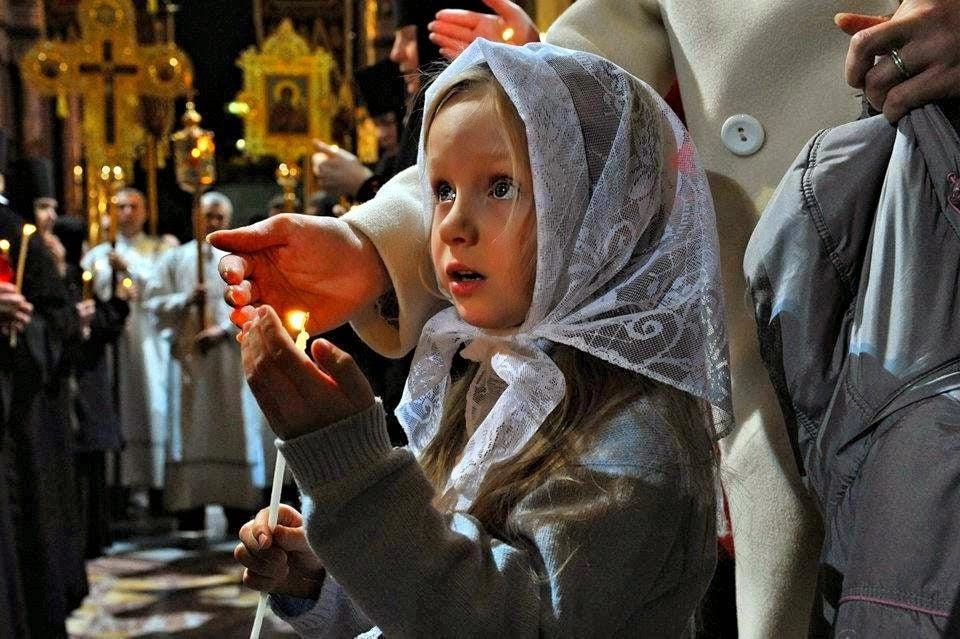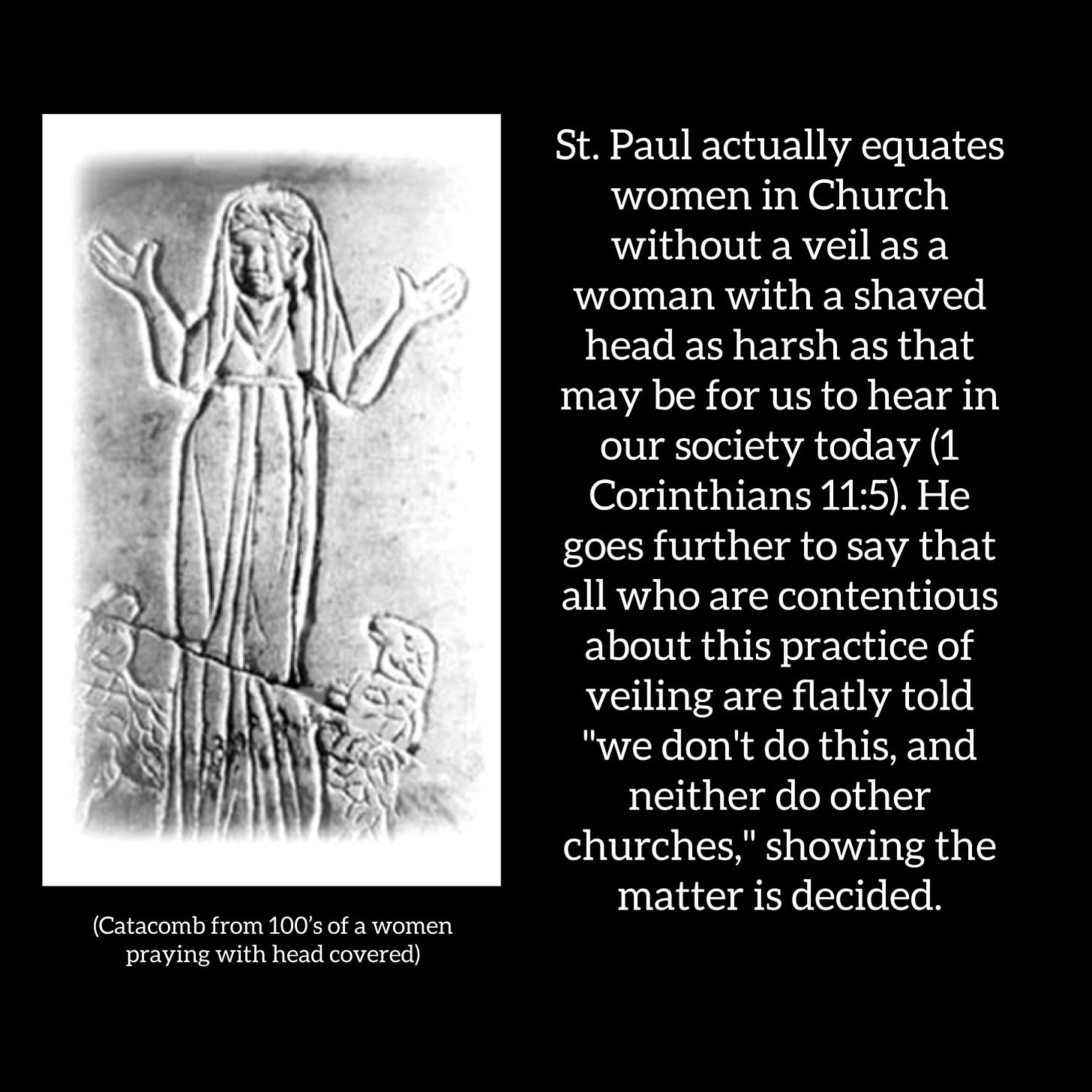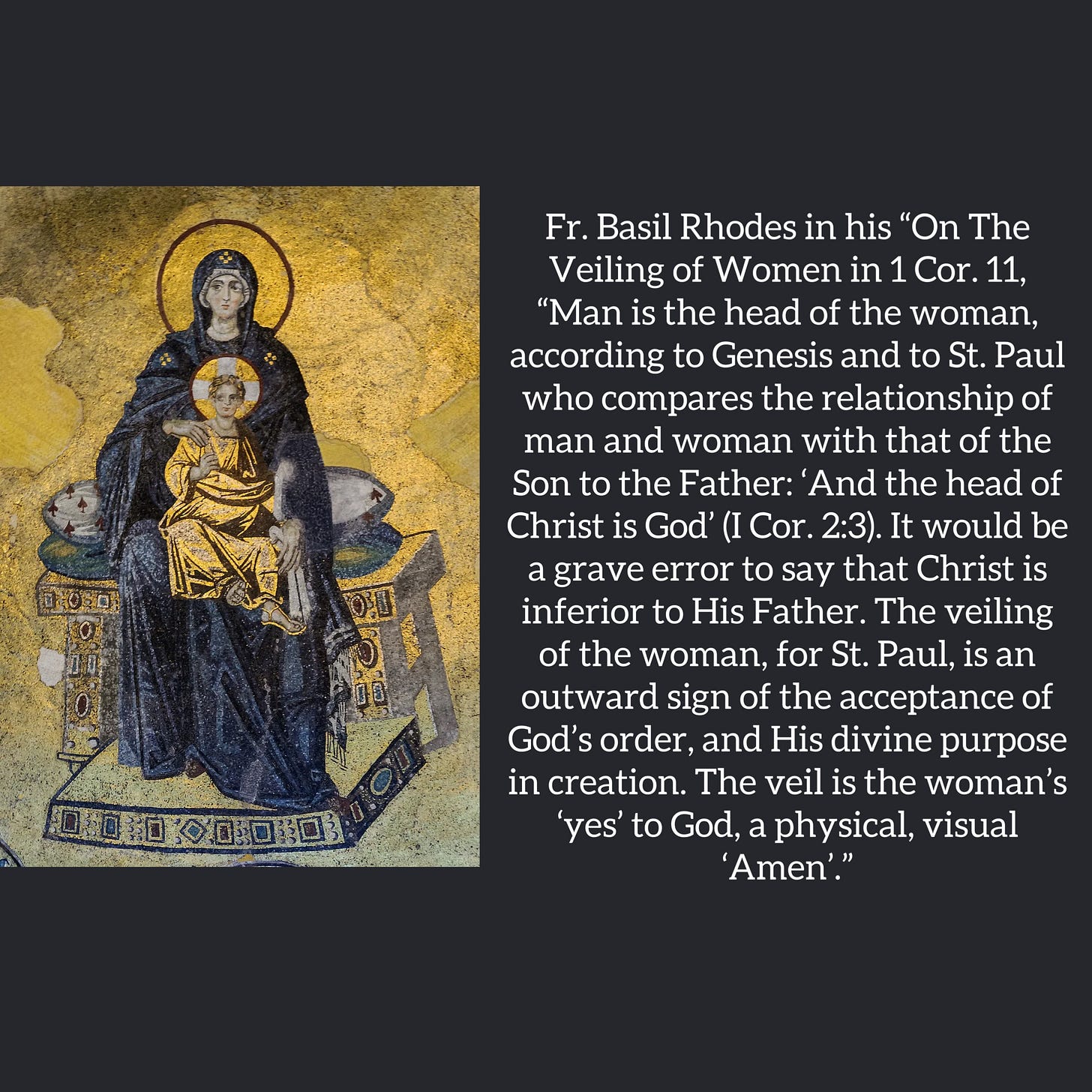A touchy subject in some Christian circles, especially with the rise of feminism is the topic of veiling or head coverings in the Church. I’m going to hone this article specifically regarding the practice in the Church, not outside of it. What is the context for such a usage? What does the Bible say about it? Did women do so throughout history? Why the change? What is the great mystery of veiling? I seek to give an answer to all of these. May my words be graced by God, in the name of the Father; the Son; and the Holy Spirit. Amen.
Context
In the context of the times, the Roman Empire wanted women to uncover, to look at their beauty for their own lust and sinful inclinations. The Roman Empire was notorious for many morally depraved acts such as orgies and pedophilia. The head covering was a way for a woman to keep her dignity, she is not for the sinful viewing of any man, but for the loving viewing of her husband.
In the case of ancient Corinth, an uncovered woman's head was interpreted as a sign of sexual availability or even prostitution. St. Paul in his letters to the Corinthians urges them to keep the traditions taught to them which includes veiling. The head covering shows that women are not property for the sexual enjoyment of any man who wishes to have them, she is not something to be used or thought of as a non-human. The veil shows her value, not only as a human but to God Himself.
Another point being, veiling is counterculture, it was in the early Church to distinguish Christians as not of this world and it’s even more counterculture today. You are seen as oppressive, behind the times, weird, etc if you veil today. “Christianity is oppressive” is ironic considering it was and is completely revolutionary to women.
Christianity made men and women equal in God, and St. Paul says this right in the middle of the passage (1 Corinthians 11) where he speaks about head coverings. It is important to remember that when Jesus and St. Paul talk about women in the Scriptures it is in a new way that was not normal to their cultures at the time.
The world teaches women to become a servant to an employer who hates you, instead of a servant to a husband who loves you. And men are also called to be a servant to their wife, and both a servant of God. Just the term “servant” will instantly send feminists into a frenzy just revealing how much distortion and pride has infected the modern age. The same mindset from the world regards veiling, even though it is meant to glorify and honor woman.
Mystery Of The Veiling
The most important reason for veiling is regarding the holiness of woman. In the Divine Liturgy, the Holy things are always covered, such as the Body and Blood of Christ in the Eucharist, and the Iconostasis with the curtain to cover the Holy of Holies. Women are encouraged to cover too, and this is partly a mystery, but my personal opinion I think it is because of woman’s holiness in being able to give birth and life into the world. Woman uniquely shares that with God who brings life into the world. The Theotokos being the example of this, her womb bore the Son of God, the Savior of the world.
Men give structure, women give life. Both are needed for the other. Structure with no life is legalism and dead, life with no structure loses meaning and is misled.
While the modern world will tell us veiling is oppressive and demeaning to women, it’s quite the opposite in the Church’s perspective from the beginning to today to the end. Women are holy, beautiful, and precious to God and to the Church; and ultimately that’s why we veil. We are also faithful to Holy Scripture where St. Paul lays out another mystery regarding the head covering.
“For this reason the woman ought to have a symbol of authority on her head, because of the angels.” - 1 Corinthians 11:10. Why because of the angels should a woman cover her head? This is partly a mystery as well, but theories have been given. Because of the angels, referencing back to the fallen angels who came down to take women as mentioned in Genesis 6, is a popular theory. They were struck by the beauty of woman, the veil reminds angels that woman was made for man, and not for them. It reminds all of creation. (I’m just stating the theory, not that I endorse it). And most simply; it is because the angels are present with us at Church which shows reverence for them, God’s creation, and His order. It is actualizes the reality of the body of Christ, which I’ll get to in a minute. So why head coverings matter to the angels is a bit mysterious, but the fact that they do matter is not mysterious.
St. Clement gives us an interpretation too, when he says, ““Because of the angels.” By the angels he means righteous and virtuous men. Let her be veiled then, that she may not lead them to stumble into fornication. For the real angels in heaven see her though veiled.” Clement of Alexandria (A.D. 195) Ante-Nicene Fathers vol.2 pg.578).
We can see natural veiling in literally how we were made by God in His image. Which no Christian would deny. Think, as we get older, men often lose their hair or their “veil” and women often do not, keeping their “veil.” God has founded this truth into our literal beings.
This is the exact reasoning St. Paul gives us in his epistles! Because woman naturally grows a veil and keeps it, so should she wear a head covering too. The spiritual and physical are not separate, such as Christ is both God and man. In keeping this tradition it maintains that connectedness of spiritual and physical in a spiritual head covering (hair) and physical head covering (veil).
St. Paul is not falling on either extreme by elevating the spiritual over the physical in saying women just need long hair. Nor is he elevating the physical over the spiritual saying women just need to cover their heads while shaving their heads. St. Paul actually equates women in Church without a veil as a woman with a shaved head as harsh as that may be for us to hear in our society today (1 Corinthians 11:5). He goes further to say that all who are contentious about this practice of veiling are flatly told "we don't do this, and neither do other churches," showing the matter is decided. No Church of his era had the practice of allowing women to pray or prophesy with uncovered heads (1 Corinthians 11:16).
He is suggesting that those who do are outside of the traditions of Christianity, can you imagine how many people would be offended by St. Paul if he were on earth today?
1 Corinthians 11 is the full exposition on head coverings for women, as well as how it is shameful for men to cover their heads. Fr. Basil Rhodes in his “On The Veiling of Women in 1 Cor. 11, “Man is the head of the woman, according to Genesis and to St. Paul who compares the relationship of man and woman with that of the Son to the Father: ‘And the head of Christ is God’ (I Cor. 2:3). It would be a grave error to say that Christ is inferior to His Father. The veiling of the woman, for St. Paul, is an outward sign of the acceptance of God’s order, and His divine purpose in creation. The veil is the woman’s ‘yes’ to God, a physical, visual ‘Amen’.” And again we cannot separate the spiritual and the physical lest we fall into delusion.
Wearing a veil in Church actualizes this reality, it differentiates us from the world, it makes a statement “this place (the Church) is different.” It’s a physical statement of a spiritual reality, saying “I submit to God’s will.” A veiled woman shows reverence for God, symbolizing the veiled bride of the Church, but also honors herself as a woman before God.
This imagery is given throughout the New Testament, of Christ the Bridegroom returning for the Church, the Bride. Man and woman are given the same imagery by St. Paul, man as Christ, woman as the Church. In veiling, women keep the physical reality of this spiritual reality, bridging the spiritual and the physical just like Christ.
Old Testament/Church History
The Old Testament is full of references to women veiling as well, such as Genesis 24:65 when Rebekah covers herself before Isaac approaches. Isaiah 47:2 speaks of the veil being taken off of those in a shameful manner regarding exposing Babylon. Numbers 5:18 portrays a woman found guilty of adultery as having her head covering taken off. Song of Solomon 5:7, “The watchmen who went about the city found me. They struck me, they wounded me; The keepers of the walls took my veil away from me.”Here we see in the Old Testament it is implied commonplace for a woman to veil, and those who are up to no good take away the veil.
Throughout Church history, we see women continually and routinely veiled while at Church. It was a standard and universal practice from the earliest days of the Christian Church. In the Catacomb of Domitila in Rome dates to 95AD where some of the earliest Christian images are, shows women with head coverings.
Even the Protestant Reformers, such as Martin Luther, John Calvin, John Knox, John Wesley (Methodist), etc all believed that women should wear a head covering in Church. Calvin said, “Should any one now object, that her hair is enough, as being a natural covering, Paul says that it is not, for it is such a covering as requires another thing to be made use of for covering it."
The Church Fathers throughout history almost unanimously teach that women should veil in Church. St. John Chrysostom says the following about head coverings, “Thus, in the beginning he simply requires that the head be not bare: but as he proceeds he intimates both the continuance of the rule, saying, "for it is one and the same thing as if she were shaven," and the keeping of it with all care and diligence. For he said not merely covered, but "covered over," meaning that she be carefully wrapped up on every side. And by reducing it to an absurdity, he appeals to their shame, saying by way of severe reprimand, "but if she be not covered, let her also be shorn." As if he had said, "If thou cast away the covering appointed by the law of God, cast away likewise that appointed by nature."
We see this tradition in marriage too, the Bride always has a veil that is lifted up during the wedding day. So what changed? The rise of feminism is certainly one indicator, with the slogans of oppression of woman. Interpretive issues have also contributed to the discarding of the tradition, with much of what we see as unveiling women in churches gained more widespread acceptance starting in the 1960’s. In 1968 there was a feminist movement called “the national unveiling of women” by the National Organization of Women (a feminist organization). They made a public display as calling women in various churches to remove their head coverings and burn them in public display. This same movement is happening across the Middle East specifically in Iran today.
Conclusion
So the question becomes, if veiling in Church was the norm for the first 1,960 years of the Christian Church, and only in the last century has it become counterculture, why would we not go with our Christian brothers and sisters before us? Why do we listen to what the world says about it? And decline to hear what the Bible says? Or even fit our own narratives over Scripture to justify what the world says? St. Paul is emphatic that there were some even in his time who did not like the practice of veiling; yet his words are clear it is the practice of the Church of God.
Now does this mean we should become ultra-rigorists and shame any woman without a head covering? No. Or does it mean we should become ultra-modernist and don’t even teach it’s meaning altogether, while totally abandoning it? Certainly no, either. I admit, I do not have a concrete solution for this and maybe you reading do or can offer one. But I do think proclaiming the truth in love is always the first step. Christ be with us.
The world intends to spin the concept of veiling into something oppressive, when in reality it’s empowering women, showing they are holy, worthy, and beautiful by God’s standard and not the world’s. It’s not a degradation, but an elevation. Please forgive me for any offense I may have caused, and may we charitably approach this issue in love and grace, seeking to keep in truth what we all love so dearly, Christianity.







I’m just curious if you are an American convert or were raised in an ethnic Orthodox family/ grew up in the faith around others who were also raised in it. My relatives from Greece were deeply religious and mystical women who literally prayed ceaselessly and none of them covered their heads outside of male monasteries. This is also the experience of many Russians and Serbians but is not to say that none of these women don’t cover their heads in church (especially Russians). As you know, Saint Paul was writing during a time when a woman with uncovered hair was essentially an adulterous tart. I am grateful we no longer live in such a time. Furthermore, Christ himself showed incredible compassion to women from all alienated walks of life and did not say a single word to them about covering their heads. In fact he admonishes the apostles for their judgment of the repenting woman who anoints him with costly oil and washes his feet WITH HER HAIR. The flip side of the women covering their heads/ hair question is when we ask ourselves why, for example, Muslim women are forced to veil themselves and what this implies about both supposedly spiritually inclined men and women. Or, why Orthodox Jewish women must cover their heads after marriage. There are some nice mystical justifications for this practice in the Judaic tradition, but what it really boils down to is more cultural than spiritual. Regardless I appreciate your effort in thoughtfully pursuing this topic and hope to write more on it in the future, too.
Thank you brother, this was very useful God bless you.